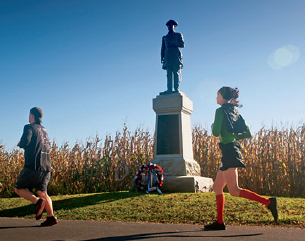In just five years, local volunteers and our race committee have taken an idea to start a race in a small town that would highlight both health and history. Our race course for Freedom’s Run takes runners past many important Civil War and Historical landmarks. Each year, the event has grown, with runners now wcoming from all over the country; in addition to a full and half-marathon, we feature a 10K, 5K, and free 1-mile race for children.
This past October, Runner’s World visited Shepherdstown, West Virginia for Freedom’s Run, and were so moved by the event that they wrote a photojournalism story that appears in the current October issue. The magazine also gave recognition in “Top 25 Half Marathons” in an earlier issue. Come visit a natural running town on October 12. Included below is the full text of the recent article, and is reposted here with Runner’s World’s permission. — Dr. Mark
 ***
***
Racing History
Freedom’s Run marathoners follow a tranquil route once traveled by Civil War soldiers
by Adam Voiland
I’m in the parking lot of the visitor’s center at Harper’s Ferry National Historical
Park in West Virginia, the first of four parks I’ll traversetoday, waiting for the start of the Freedom’s Run Marathon. In the half-light of October dawn, the scene
is surreal.
There’s a golden glow on everything, from the sculpted Blue Ridge Mountains
above to the winding waters of the Shenandoah and Potomac rivers below.
At the confluence of the two, water has sliced through two separate ridges, creating a distinctive notch in the mountains. Meanwhile, a few runners wearing garbage bags to keep warm wander past.
I’m downing a cup of thin coffee while a recording of the national anthem playsin the background. The race director uses a bullhorn to wish us luck. And with that,we’re off, charging into the mist. I’m here to wage a battle…of sorts. Like all marathoners, I’ve dragged myself out of bed at this ungodly hour to prove my mettle—and the soundness of my training strategy—in a fight against the clock.But I’m here by choice. And fingers crossed, I’m going to make it home alive
Near the start, there are occasional hollers from spectators, but soon it’s just the soft padding of shoe on pavement, then shoe on gravel as we make our way through a field enveloped by fog and dotted with cannons. Hill’s Confederates would have been more likely to hear the clatter of canteens and rifles rattling as they stumbled ahead—their pace was grueling, so fast that hundreds of Hill’s exhausted men were left behind.
 Freedom’s Run is the right name for this remarkable race. After all, Harper’s Ferry is the place where abolitionist John Brown led a slave rebellion in the fall of 1859 that agitated Americans in a way that nothing ever had before. Authorities crushed Brown’s uprising after a brief standoff, but historians still credit him with igniting one of the first sparks of the Civil War. Around mile four we pass a brick building, part of the arsenal where his raiders made their last stand.
Freedom’s Run is the right name for this remarkable race. After all, Harper’s Ferry is the place where abolitionist John Brown led a slave rebellion in the fall of 1859 that agitated Americans in a way that nothing ever had before. Authorities crushed Brown’s uprising after a brief standoff, but historians still credit him with igniting one of the first sparks of the Civil War. Around mile four we pass a brick building, part of the arsenal where his raiders made their last stand.
I’ve settled into a comfortable rhythm. I cross over the Potomac River on a pedestrian
bridge. The river, glimmering in the sunshine below, is breathtaking. For the next 10 miles, the course hugs the C&O Canal towpath, a perfect running surface of crushed gravel and clay. With tulip poplars towering overhead and thick walls of pawpaw on either side, I feel like I’m moving through a tunnel carved in solid forest.
The course is flat along the river. It’s only later, as we approach the actual battlefield, that we’re confronted with a series of rolling hills. As I grapple with them, my mind drifts to Hill’s men again. I wonder whether I would have been able to do what they did. After their marathonlike march, they were sent immediately into battle, ultimately saving a faltering Confederate Army from destruction.
About 18 miles in, we’ve reached the boundaries of Antietam National Battlefield. Cannons and statues line the road the race follows through the park. Fields of corn stand solemnly by, maintained to look like they did during the battle. Somehow I never get winded. I never hit the wall or even come close to it. The richness and depth of the history, along with the beauty of the landscape, fuels me in a way that few other places can.

Amazing! Itts inn fact awesome piece of writing, I have
got much clear idea regarding from this post.